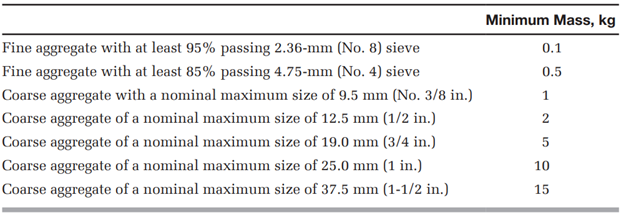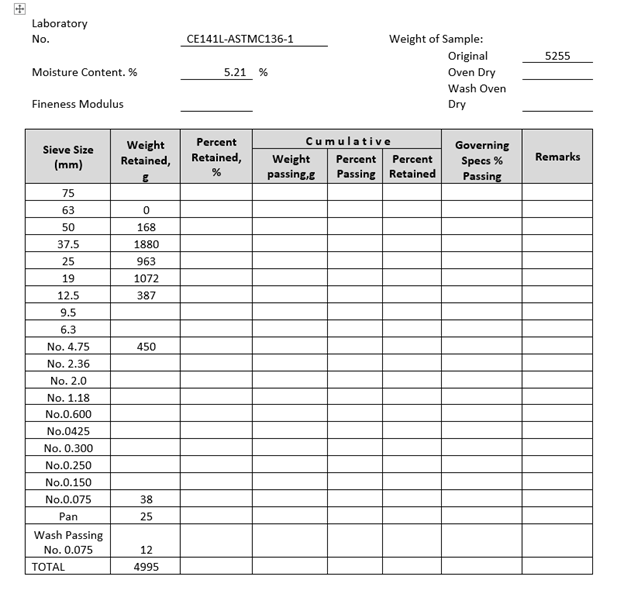TEST PROCEDURE: 1. Dry the aggregate test sample to a constant weight at a temperature of 110 ± 5°C, then cool to room temperature. 2. Select suitable sieve sizes to furnish the information required by the specifications covering the material to be tested. Common sieves in millimeters are 37.5, 25, 19, 12.5, 9.5, 4.75, 2.36, 1.18, 0.6, 0.3, 0.15, and 0.075 mm (11 2 in., 1 in., 3 4 in., 1 2 in., 3 8 in., No. 4, No. 8, No. 16, No. 30, No. 50, No. 100, and No. 200). 3. Nest the sieves in order of decreasing size of opening, and place the aggregate sample on the top sieve. 4. Agitate the sieves by hand or by mechanical apparatus for a sufficient period. The criterion for sieving time is that, after completion, not more than 1% of the residue on any individual sieve will pass that sieve during 1 minute of continuous hand sieving. 5. Determine the weight of each size increment. 6. The total weight of the material after sieving should be compared with the original weight of the sample placed on the sieves. If the amounts differ by more than 0.3%, based on the original dry sample weight, the results should not be used for acceptance purposes. FOR THE TABLE: Compute individual percent retained, cumulative percent retained and percent passing. Make a particle size distribution chart using semi log using excel. Compute the fineness modulus of the sample. Identify whether weight percent within the governing specs passed.
TEST PROCEDURE:
1. Dry the aggregate test sample to a constant weight at a temperature of 110 ± 5°C, then cool to room temperature.
2. Select suitable sieve sizes to furnish the information required by the specifications covering the material to be tested. Common sieves in millimeters are 37.5, 25, 19, 12.5, 9.5, 4.75, 2.36, 1.18, 0.6, 0.3, 0.15, and 0.075 mm (11 2 in., 1 in., 3 4 in., 1 2 in., 3 8 in., No. 4, No. 8, No. 16, No. 30, No. 50, No. 100, and No. 200).
3. Nest the sieves in order of decreasing size of opening, and place the aggregate sample on the top sieve.
4. Agitate the sieves by hand or by
5. Determine the weight of each size increment.
6. The total weight of the material after sieving should be compared with the original weight of the sample placed on the sieves. If the amounts differ by more than 0.3%, based on the original dry sample weight, the results should not be used for acceptance purposes.
FOR THE TABLE:
- Compute individual percent retained, cumulative percent retained and percent passing.
- Make a particle size distribution chart using semi log using excel.
- Compute the fineness modulus of the sample.
- Identify whether weight percent within the governing specs passed.


Trending now
This is a popular solution!
Step by step
Solved in 2 steps with 3 images


